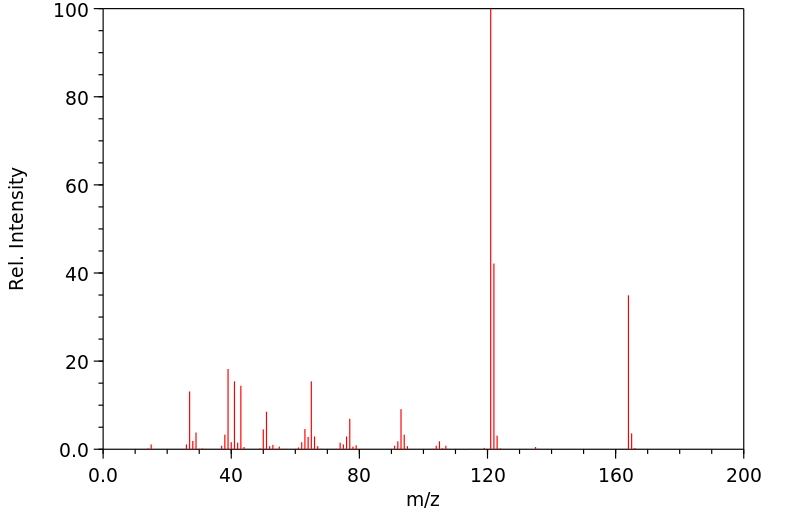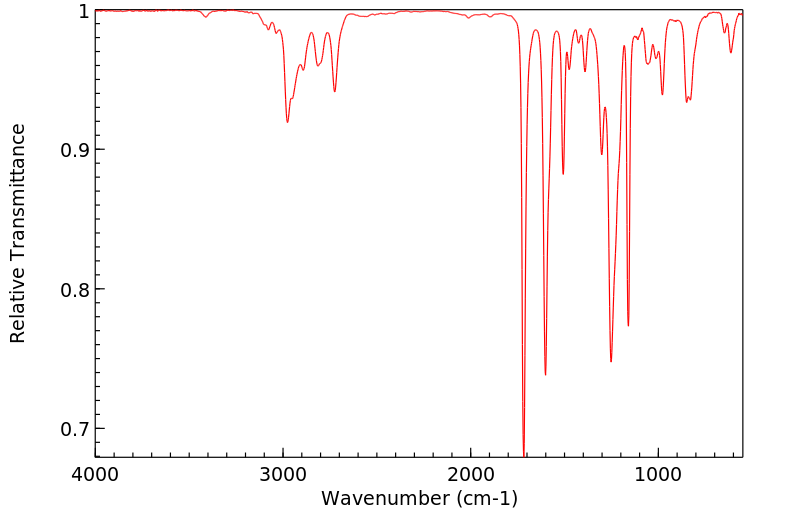4-丙氧基苯甲醛 | 5736-85-6
中文名称
4-丙氧基苯甲醛
中文别名
4-N-丙氧基苯甲醛;4-正丙氧基苯甲醛;对丙氧基苯醛
英文名称
4-propoxybenzaldehyde
英文别名
4-propyloxybenzaldehyde;4-n-propoxybenzaldehyde;p-propoxybenzaldehyde;4-n-propyloxybenzaldehyde
CAS
5736-85-6;870839-25-1
化学式
C10H12O2
mdl
MFCD00014134
分子量
164.204
InChiKey
FGXZWMCBNMMYPL-UHFFFAOYSA-N
BEILSTEIN
——
EINECS
——
-
物化性质
-
计算性质
-
ADMET
-
安全信息
-
SDS
-
制备方法与用途
-
上下游信息
-
文献信息
-
表征谱图
-
同类化合物
-
相关功能分类
-
相关结构分类
物化性质
-
熔点:268 °C
-
沸点:129-130 °C/10 mmHg (lit.)
-
密度:1.039 g/mL at 25 °C (lit.)
-
闪点:>230 °F
计算性质
-
辛醇/水分配系数(LogP):2.1
-
重原子数:12
-
可旋转键数:4
-
环数:1.0
-
sp3杂化的碳原子比例:0.3
-
拓扑面积:26.3
-
氢给体数:0
-
氢受体数:2
安全信息
-
TSCA:T
-
危险等级:IRRITANT
-
危险品标志:Xn,Xi
-
安全说明:S26,S27,S36/37/39
-
危险类别码:R22
-
WGK Germany:3
-
海关编码:2912499000
-
危险品运输编号:UN3334
-
RTECS号:CU7700000
-
包装等级:Z01
-
危险性防范说明:P261,P280,P305+P351+P338
-
危险性描述:H302+H312+H332,H315,H319,H335
SDS
上下游信息
-
上游原料
中文名称 英文名称 CAS号 化学式 分子量 4-(3-溴丙基氧基)苯甲醛 4-(3-bromopropoxy)benzaldehyde 17954-81-3 C10H11BrO2 243.1 4-烯丙氧基苯甲醛 4-(2-propenyloxy)benzaldehyde 40663-68-1 C10H10O2 162.188 1-甲基-4-丙氧基苯 4-methylphenol n-propyl ether 5349-18-8 C10H14O 150.221 (4-丙氧基苯基)甲醇 (4-propoxyphenyl)methanol 90925-43-2 C10H14O2 166.22 1-(氯甲基)-4-丙氧基苯 (4-chloromethyl-phenyl)-propyl ether 40141-11-5 C10H13ClO 184.666 对羟基苯甲醛 4-hydroxy-benzaldehyde 123-08-0 C7H6O2 122.123 丙氧基苯 propoxybenzene 622-85-5 C9H12O 136.194 -
下游产品
中文名称 英文名称 CAS号 化学式 分子量 4-丙氧基苯甲酸 4-propoxybenzoic acid 5438-19-7 C10H12O3 180.203 1-(4-丙氧基-苯基)-乙酮 1-(4-propoxyphenyl)ethanone 5736-86-7 C11H14O2 178.231 (4-丙氧基苯基)甲醇 (4-propoxyphenyl)methanol 90925-43-2 C10H14O2 166.22 1-丙氧基-4-乙烯基苯 1-propoxy-4-vinylbenzene 80122-67-4 C11H14O 162.232 1-(氯甲基)-4-丙氧基苯 (4-chloromethyl-phenyl)-propyl ether 40141-11-5 C10H13ClO 184.666 —— 4-propyloxybenzyl mercaptan 63550-20-9 C10H14OS 182.287 1-(溴甲基)-4-丙氧基苯 1-(bromomethyl)-4-propoxybenzene 2606-58-8 C10H13BrO 229.117 —— 4-propyloxybenzaldoxime 61096-85-3 C10H13NO2 179.219 —— p-(n-Propyloxy)-benzylcyanid 50690-52-3 C11H13NO 175.23 —— (E)-1,2-bis(4-propoxyphenyl)ethene 36931-02-9 C20H24O2 296.409 3-(4-丙氧基苯基)丙-2-烯醛 4-Propoxycinnamaldehyde 918831-19-3 C12H14O2 190.242 N-苄基-1-(4-丙氧基苯基)甲胺 N-benzyl-1-(4-propoxyphenyl)methanamine 1042551-88-1 C17H21NO 255.36 3-氯-4-丙氧基苯甲醛 3-chloro-4-propoxybenzaldehyde 99070-71-0 C10H11ClO2 198.649 —— 4,4'-di-n-propyloxybenzalazine 99163-22-1 C20H24N2O2 324.423 —— 4-(4-Propoxyphenyl)butan-1-amine 211692-48-7 C13H21NO 207.316 —— N'-[(4-propoxyphenyl)methyl]ethane-1,2-diamine 1184530-53-7 C12H20N2O 208.304 —— 4-bromo-4'-propoxybenzophenone —— C16H15BrO2 319.198 4-丙氧基-苯丙酸 3-(4-propoxy-phenyl)-propionic acid 3243-40-1 C12H16O3 208.257 —— 4-propoxybenzaldehyde dimethyl acetal —— C12H18O3 210.273 —— 4t-(4-propoxy-phenyl)-but-3-en-2-one 37080-12-9 C13H16O2 204.269 对丙氧基肉桂酸 4-propoxycinnamic acid 69033-81-4 C12H14O3 206.241 —— 4-propoxycinnamic acid 69033-81-4 C12H14O3 206.241 —— 4-formylphenyl 4-propyloxybenzoate 56800-28-3 C17H16O4 284.312 4-丙氧基苯酚 4-propoxyphenol 18979-50-5 C9H12O2 152.193 —— N,N-Dimethyl-N'-(4-propyloxy-benzyl)-aethylendiamin 92377-10-1 C14H24N2O 236.357 —— 2-(4'-propoxyphenyl)-1-nitroethene 6946-31-2 C11H13NO3 207.229 —— 2-(4-propyloxybenzylamino)acetic acid 1094329-08-4 C12H17NO3 223.272 —— 4-propoxycinnamic acid 77251-76-4 C12H13ClO2 224.687 —— (E)-3-(4-Propoxy-phenyl)-acryloyl chloride 118938-42-4 C12H13ClO2 224.687 —— <4-Propyloxy-benzyliden>-malonsaeure-dinitril —— C13H12N2O 212.251 —— 3-(Chloromethyl)-4-propoxybenzaldehyde 1171935-92-4 C11H13ClO2 212.676 —— 2-Hydroxy-2-(4-propoxyphenyl)acetonitrile 1247740-32-4 C11H13NO2 191.23 —— [(4-Propoxyphenyl)methylideneamino]thiourea 5351-86-0 C11H15N3OS 237.326 —— (E)-1-(4-hydroxyphenyl)-3-(4-propoxyphenyl)prop-2-en-1-one —— C18H18O3 282.339 - 1
- 2
- 3
- 4
反应信息
-
作为反应物:描述:4-丙氧基苯甲醛 在 4-二甲氨基吡啶 、 potassium permanganate 、 sodium dihydrogenphosphate 、 ammonium cerium (IV) nitrate 作用下, 以 水 、 N,N-二甲基甲酰胺 为溶剂, 反应 3.25h, 生成 4-formylphenyl 4-propyloxybenzoate参考文献:名称:2-Aryl benzazole derived new class of anti-tubercular compounds: Endowed to eradicate mycobacterium tuberculosis in replicating and non-replicating forms摘要:The high mortality rate and the increasing prevalence of Mtb resistance are the major concerns for the Tuberculosis (TB) treatment in this century. To counteract the prevalence of Mtb resistance, we have synthesized 2-aryl benzazole based dual targeted molecules. Compound 9m and 9n were found to be equally active against replicating and non-replicating form of Mtb (MIC(MABA) 1.98 and 1.66 mu g/ml; MIC(LORA) 2.06 and 1.59 mu g/ml respectively). They arrested the cell division (replicating Mtb) by inhibiting the GTPase activity of FtsZ with IC50 values 45 and 64 mu M respectively. They were also capable of kill Mtb in non-replicating form by inhibiting the biosynthesis of menaquinone which was substantiated by the MenG inhibition (IC50 = 11.62 and 7.49 mu M respectively) followed by the Vit-K2 rescue study and ATP production assay.DOI:10.1016/j.bioorg.2020.104170
-
作为产物:参考文献:名称:醛和酮的形成:苯乙酸和α-羟基苯基乙酸的铜催化好氧氧化脱羧摘要:已经合成了由铜催化的苯乙酸和α-羟基苯基乙酸的需氧氧化脱羧反应得到的芳香醛或酮。该反应以分子氧作为唯一的终端氧化剂,在一个一站式方案中结合了脱羧,双氧活化和C–H键氧化步骤。该反应代表了sp 3-杂化碳的新型脱羧作用,以及使用苄基羧酸作为羰基化合物的来源。DOI:10.1021/jo402778p
文献信息
-
Structure-Guided Design, Synthesis, and Characterization of Next-Generation Meprin β Inhibitors作者:Daniel Ramsbeck、Antje Hamann、Georg Richter、Dagmar Schlenzig、Stefanie Geissler、Vera Nykiel、Holger Cynis、Stephan Schilling、Mirko BuchholzDOI:10.1021/acs.jmedchem.8b00330日期:2018.5.24The metalloproteinase meprin β emerged as a current drug target for the treatment of a number of disorders, among those fibrosis, inflammatory bowel disease and Morbus Alzheimer. A major obstacle in the development of metalloprotease inhibitors is target selectivity to avoid side effects by blocking related enzymes with physiological functions. Here, we describe the structure-guided design of a novel
-
Ambient Hydrogenation and Deuteration of Alkenes Using a Nanostructured Ni‐Core–Shell Catalyst作者:Jie Gao、Rui Ma、Lu Feng、Yuefeng Liu、Ralf Jackstell、Rajenahally V. Jagadeesh、Matthias BellerDOI:10.1002/anie.202105492日期:2021.8.16selective hydrogenation and deuteration of a variety of alkenes is presented. Key to success for these reactions is the use of a specific nickel-graphitic shell-based core–shell-structured catalyst, which is conveniently prepared by impregnation and subsequent calcination of nickel nitrate on carbon at 450 °C under argon. Applying this nanostructured catalyst, both terminal and internal alkenes, which
-
Chemoselective Hydrogenation of Olefins Using a Nanostructured Nickel Catalyst作者:Mara Klarner、Sandra Bieger、Markus Drechsler、Rhett KempeDOI:10.1002/zaac.202100124日期:2021.11.25pharmaceutical industry. Here, we report on a nanostructured nickel catalyst that enables the selective hydrogenation of purely aliphatic and functionalized olefins under mild conditions. The earth-abundant metal catalyst allows the selective hydrogenation of sterically protected olefins and further tolerates functional groups such as carbonyls, esters, ethers and nitriles. The characterization of our
-
Photoredox‐Catalyzed Simultaneous Olefin Hydrogenation and Alcohol Oxidation over Crystalline Porous Polymeric Carbon Nitride作者:Chuntian Qiu、Yangyang Sun、Yangsen Xu、Bing Zhang、Xu Zhang、Lei Yu、Chenliang SuDOI:10.1002/cssc.202101041日期:2021.8.23Booming of photocatalytic water splitting technology (PWST) opens a new avenue for the sustainable synthesis of high-value-added hydrogenated and oxidized fine chemicals, in which the design of efficient semiconductors for the in-situ and synergistic utilization of photogenerated redox centers are key roles. Herein, a porous polymeric carbon nitride (PPCN) with a crystalline backbone was constructed光催化水分解技术(PWST)的蓬勃发展为高附加值氢化和氧化精细化学品的可持续合成开辟了新途径,其中设计用于原位和协同利用光生氧化还原中心的高效半导体是关键角色。在此,构建了具有结晶主链的多孔聚合氮化碳(PPCN),用于通过光激发电子在可见光诱导的光催化产氢,然后原位用于烯烃加氢。同时,通过光激发空穴选择性地将各种醇转化为有价值的醛或酮。PPCN 的孔隙率为其提供了大的表面积和光生载流子从本体到表面的短传输路径,晶体结构促进了光生电荷的转移和分离,从而提高了整体光催化性能。这种协同的光催化体系实现了高反应性和选择性、良好的官能度耐受性和广泛的反应范围。研究结果有助于开发高效的半导体光催化剂和基于 PWST 的协同氧化还原反应体系,用于高附加值精细化学品生产。
-
Chemoselective hydrogenation method catalyzed by Pd/C using diphenylsulfide as a reasonable catalyst poison作者:Akinori Mori、Tomoteru Mizusaki、Yumi Miyakawa、Eri Ohashi、Tomoko Haga、Tomohiro Maegawa、Yasunari Monguchi、Hironao SajikiDOI:10.1016/j.tet.2006.09.094日期:2006.12using Pd/C, we investigated catalyst poison as a controller of the catalyst activity. We found that the addition of Ph2S (diphenylsulfide) to the Pd/C-catalyzed hydrogenation reaction mixture led to reasonable deactivation of Pd/C. By the use of the Pd/C–Ph2S catalytic system, olefins, acetylenes, and azides can be selectively reduced in the coexistence of aromatic carbonyls, aromatic halides, cyano
表征谱图
-
氢谱1HNMR
-
质谱MS
-
碳谱13CNMR
-
红外IR
-
拉曼Raman
-
峰位数据
-
峰位匹配
-
表征信息
同类化合物
(R)-3-(叔丁基)-4-(2,6-二异丙氧基苯基)-2,3-二氢苯并[d][1,3]氧杂磷杂环戊烯
(2S,3R)-3-(叔丁基)-2-(二叔丁基膦基)-4-甲氧基-2,3-二氢苯并[d][1,3]氧杂磷杂戊环
(2S,2''S,3S,3''S)-3,3''-二叔丁基-4,4''-二甲氧基-2,2'',3,3''-四氢-2,2''-联苯并[d][1,3]氧杂磷杂戊环
(2R,2''R,3R,3''R)-3,3''-二叔丁基-4,4''-二甲氧基-2,2'',3,3''-四氢-2,2''-联苯并[d][1,3]氧杂磷杂戊环
(2-氟-3-异丙氧基苯基)三氟硼酸钾
(+)-6,6'-{[(1R,3R)-1,3-二甲基-1,3基]双(氧)}双[4,8-双(叔丁基)-2,10-二甲氧基-丙二醇
麦角甾烷-6-酮,2,3,22,23-四羟基-,(2a,3a,5a,22S,23S)-
鲁前列醇
顺式6-(对甲氧基苯基)-5-己烯酸
顺式-铂戊脒碘化物
顺式-四氢-2-苯氧基-N,N,N-三甲基-2H-吡喃-3-铵碘化物
顺式-4-甲氧基苯基1-丙烯基醚
顺式-2,4,5-三甲氧基-1-丙烯基苯
顺式-1,3-二甲基-4-苯基-2-氮杂环丁酮
非那西丁杂质7
非那西丁杂质3
非那西丁杂质22
非那西丁杂质18
非那卡因
非布司他杂质37
非布司他杂质30
非布丙醇
雷诺嗪
阿达洛尔
阿达洛尔
阿莫噁酮
阿莫兰特
阿维西利
阿索卡诺
阿米维林
阿立酮
阿曲汀中间体3
阿普洛尔
阿普斯特杂质67
阿普斯特中间体
阿普斯特中间体
阿托西汀EP杂质A
阿托莫西汀杂质24
阿托莫西汀杂质10
阿托莫西汀EP杂质C
阿尼扎芬
阿利克仑中间体3
间苯胺氢氟乙酰氯
间苯二酚二缩水甘油醚
间苯二酚二异丙醇醚
间苯二酚二(2-羟乙基)醚
间苄氧基苯乙醇
间甲苯氧基乙酸肼
间甲苯氧基乙腈
间甲苯异氰酸酯








